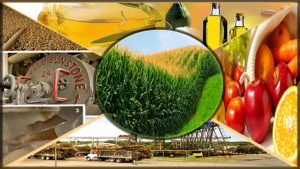Climate Friendly
The synthetic inputs upon which conventional agriculture is so dependent are energy expensive to mine and manufacture. Today the embodied energy of industrial agriculture uses up 9 calories for every 1 calorie of food that it produces!
Organic agriculture with its low input needs of naturally derived substances produces less greenhouse gas emissions and is considerably more climate friendly.
Ecologically Friendly
It doesn’t use soluble fertilizers…
Though rarely acknowledged, the chief source of the annual algae blooms that plague Perth’s major river (the Swan) is conventional agriculture.
Farmers pour tons of phosphate and nitrogenous fertilizer on their cropping lands every year. Because it is soluble, much of this fertilizer is either washed off the soil surface and into waterways (especially phosphates) or leaches through the soil profile beyond the reach of plants and finds its way less directly into waterways (especially nitrates). Nitrate contamination of groundwater (indicated by >10 mg/L nitrate) in Australia is widespread in every state and territory, occurring over regional and local scales (LWRRDC 1999). In many areas, the concentration is greater than the recently revised Australian Drinking Water Guidelines level of 50 mg/L nitrate (as nitrate), resulting in groundwater that is unfit for drinking. In some of the more contaminated areas, the concentration is in excess of 100 mg/L (LWRRDC 1999).
With fresh water reserves under increasing pressure from climate change this is a grave situation for humanity.
The soluble nutrient pollutants that contaminate surface waters fuel the overgrowth of algae. What is not used up by algae in fresh waterways, spews out into the ocean where it supports the growth of algae on sea plants and coral reef systems. This blocks access to sunlight, causing whatever it smothers to die.
Eighty percent of the seagrass meadows in Perth’s Cockburn Sound – an important nursery habitat for wild fish stocks – have been decimated due to this process which is called “eutrophication”.
It doesn’t use pesticides or herbicides
Another pollution disaster caused by agrichemical use is the contamination of groundwater reserves with poisonous nasties, particularly (in Australia) Atrazine and Simazine, but also Dieldrin, Chlorpyriphos, Amitrol, Metolachlor, Trifluraline and Diuron Dieldrin, Lindane, and Alachlor.
While systematic monitoring of pesticide contamination of groundwater in Australia is limited, available tests have detected pesticides in at least 20% of samples, indicating significant contamination (Australia State of the Environment Report 2001).
Groundwater studies in the US have found similarly significant contamination. In Carolina, for example, over 27% of wells sampled in 1997 were found to be contaminated with pesticides predominantly from routine agricultural usage.
 There is no economically viable method to clean up widespread contamination. Pesticide contamination poses a serious, unreasonable public health threat to current and future ground water users.advantages and disadvantages organic farming
There is no economically viable method to clean up widespread contamination. Pesticide contamination poses a serious, unreasonable public health threat to current and future ground water users.advantages and disadvantages organic farming
Synthetic agrichemicals (and most plastics widely used in our society) are derived from oil, and thus a source of endocrine-disrupting chemicals (especially xenoestrogens) in the environment. Distorted sex organ development and function in alligators has been related to a major pesticide spill into a lake in Florida, U.S.A.advantages and disadvantages organic farming
There is also evidence to link xenoestrogens to a range of human medical concerns, particularly reproductive problems such as reduced sperm count in men and breast cancer in women.
Even the “safest” herbicides such as Roundup (glycophosphate) – the second most widely used in the USA – are now known to pose a danger to wetland ecologies, and can totally decimate frog populations at routine contamination levels.







